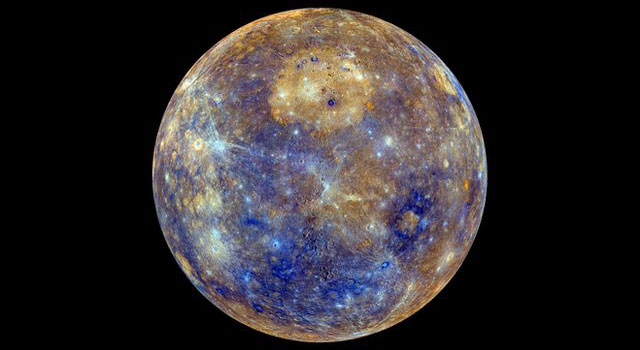 |
NASA's
MESSENGER mission and the International Astronomical Union (IAU) are
giving schools the chance to officially name five scientifically
significant craters on Mercury. The deadline for submission is 2015 January
15.
Schools and school districts can participate by visiting the contest website:
Link >>> http://namecraters.carnegiescience.edu and filling out the online form. Submissions must be in accordance with IAU rules, which require Mercury's impact craters be named in honor of people who have made outstanding or fundamental contributions to the arts and humanities; who have been recognized as historically significant figures for more than 50 years; and who have been dead at least three years. Learn more about the IAU's naming conventions and read the official rules, here: Link >>> http://namecraters.carnegiescience.edu/rules-for-naming-craters-on-mercury
The
entries will be reviewed by MESSENGER team representatives and expert
panels, and 15 finalists' names will be submitted to the IAU for
selection of the 5 winners. Winning submissions will be announced in
late March / April 2015.
While
only a few submissions will be selected, teachers should consider the
myriad teachable moments afforded by this competition in terms of
researching important persons in the arts and humanities; learning about
Mercury, planetary science and the MESSENGER spacecraft.
The
MESSENGER spacecraft arrived at Mercury in March 2011 and became the
first spacecraft to orbit the planet, returning thousands of images and
yielding a high-resolution global map. This spring, the historic
planetary mission will come to its planned mission end as the tiny craft
succumbs to gravity and impacts Mercury. It is the goal of the
MESSENGER education and public outreach team to celebrate this
remarkable story of human exploration with the public in order to foster
awareness of the mission and planetary science, and to recognize that
human exploration over the ages has been undertaken across a
trans-disciplinary tapestry of the arts and sciences.
MESSENGER
was designed and built by the Applied Physics Laboratory, Laurel, Md.
The lab manages and operates the mission for NASA's Science Mission
Directorate in Washington. The mission is part of NASA's Discovery
Program, managed for the directorate by the agency's Marshall Space
Flight Center in Huntsville, Ala.
|
Want to receive SpaceWatchtower blog posts in your inbox ?
Send request to < spacewatchtower@planetarium.cc >..
gaw
Glenn A. Walsh, Project Director,
Friends of the Zeiss < http://buhlplanetarium.tripod.com/fotz/ >
Electronic Mail - < gawalsh@planetarium.cc >
SpaceWatchtower Blog: < http://spacewatchtower.blogspot.com/ >
Also see: South Hills Backyard Astronomers Blog: < http://shbastronomers.blogspot.com/ >
Barnestormin: Writing, Essays, Pgh. News, & More: < http://www.barnestormin.blogspot.com/ >
About the SpaceWatchtower Editor / Author: < http://buhlplanetarium2.tripod.com/weblog/spacewatchtower/gaw/ >
SPACE & SCIENCE NEWS, ASTRONOMICAL CALENDAR:
< http://buhlplanetarium.tripod.
Twitter: < https://twitter.com/spacewatchtower >
Facebook: < http://www.facebook.com/pages/
Author of History Web Sites on the Internet --
* Buhl Planetarium, Pittsburgh:
< http://www.planetarium.
* Adler Planetarium, Chicago:
< http://adlerplanetarium.
* Astronomer, Educator, Optician John A. Brashear:
< http://johnbrashear.tripod.com >
* Andrew Carnegie & Carnegie Libraries:
< http://www.andrewcarnegie.
* Civil War Museum of Andrew Carnegie Free Library:
< http://garespypost.tripod.com >
* Duquesne Incline cable-car railway, Pittsburgh:
< http://inclinedplane.tripod.
* Public Transit:
< http://andrewcarnegie2.tripod.
No comments:
Post a Comment